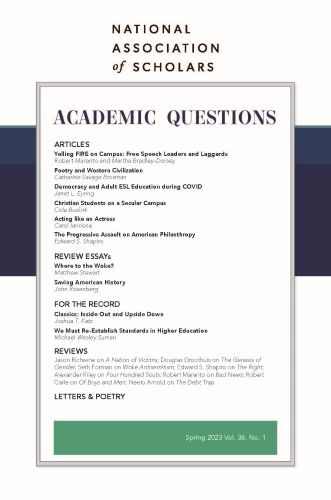Cola Buskirk’s article “The Sugar Babies of Stanford University,” appeared on the Pirate Wires Substack and in Realclearpolitics.com on Sept. 14, 2022.
When he first arrived on Stanford University’s campus, Brian never expected to spend an evening drinking with his fraternity brothers and teaching them about Christian love. Nonetheless, now in his junior year, moments like these have become more and more common. One night at his fraternity house, Brian had a friendly debate with one of his brothers about the four loves of C.S. Lewis. His friend, as Brian described it, argued for a radical pursuit of your own self-interest over a Lewisian, or Christian, ideal of selfless love.
As various people passed in and out of the room where they debated, some paused to listen or contribute. To Brian’s surprise, his argument in favor of Christian love, and not the argument for self-interest, appealed to his fraternity brothers. When considering why this may be the case, Brian said, “It’s not interesting for somebody to tell you to radically pursue your own self-interest. Nothing is meaningful about that.”
More moments like this followed for Brian, who himself had gone from being passively religious as a child to an agnostic teenager to, now, a serious Catholic. His nonreligious friends ask him about his faith and theology or simply for advice on personal problems, to which he often responds with biblical wisdom. Much to their surprise, two other Christian students at Stanford, Isabella and Jack, experienced the same with their respective friends.
Despite the warnings given to young Christian students about hedonistic college campuses, many of these students arrive at Stanford to instead find a plethora of lively Christian organizations and their nonreligious classmates often more curious than hostile. Stanford by no means espouses Christian values, but hedonism in any true sense of the word has died and left its rotting carcass for crows. Hookup culture and casual drug use abound. Freshmen are required to attend the university-sponsored “Beyond Sex Ed,” in which upperclassmen graphically recount their sexual experiences, but no one seems to take any pleasure in it. All the talk of sexual liberation and individual empowerment (sexual or otherwise) covers up the more dismal and sinister reality. Gone are the excesses of the Sixties or even of more recent frat-comedy movies. Hedonism does not rule campus anymore, but rather a heavy fog of existential despair.
The three Christian students I interviewed, Isabella and friends Brian and Jack, remarked on the shockingly casual confessions of their fellow students: “I’m so depressed,” or “life is suffering.” Phrases like this, common among the student body, are often scribbled on desks at Green Library or spoken like self-deprecating jokes to friends. Others laugh along and agree that they too are depressed, anxious, and suffering. As of 2022 Stanford has a higher suicide rate than the national average.1
No easy answer exists as to why despair reigns nor how to solve it, though most students recognize it as a problem. Some point fingers at the university, while others point to the broader trend of collapsing American communities (as documented in Robert D. Putnam’s 2000 book Bowling Alone or Charles Murray’s 2012 Coming Apart); to growing up with incessant social media use, which has frequently been linked to depression and anxiety; or to the long-stagnating wages and mounting student debt that makes it almost impossible for young people to do as well or better than their parents did. Stanford graduates have some of the most promising chances to overcome these setbacks, and yet even one of the best universities in the world is not immune.
When I asked Jack, a senior financial officer of one of the largest Protestant groups on campus, Chi Alpha, what he expected of Stanford, he said, “I thought I was going literally into the mouth of Babylon.” He spent the summer before his freshman year studying Christian apologetics, prepared to defend his faith to what he expected would be hordes of militant heathens. But for the most part, he realized,
People were kind of apathetic towards Christianity. Sure, there was hostility and there were general views that are obviously implicitly against the Christian faith, like ‘Beyond Sex Ed.’. . . For the most part, I was excited and surprised to see how many Christians there are who do not agree with the general narrative or attitude pushed by Stanford.
Though she didn’t spend her pre-freshman summer with apologetics, Isabella had equally low hopes—and Stanford’s Christian life well surpassed her expectations. In high school, she was continually warned of the importance of joining a Christian group in college because “college is crazy.” Taking that advice to heart, Isabella joined Chi Alpha as well. “All of a sudden,” she recollects, “there were all these really cool, really smart, really interesting people who were also serious about following God. . . . I was like, where have you been my whole life?”
Several Christian organizations exist on campus, including Chi Alpha Christian Fellowship, Reformed University Fellowship, and Fellowship of Christian Athletes in Action. These organizations host weekly meetings of singing and sermons as well as Bible studies and retreats at least once a school year for members. To all three of these students, and many more, Christian organizations on campus stand as places of strong, lively community and a haven amidst the despair and apathy of the broader culture. The contrast with the pervasive campus culture, rather than alienating Christian groups from campus, helps them thrive.
Brian, Jack, Isabella, and most Christian students on campus, face the same fears, problems, and confusions as their nonreligious classmates. But Christian students can turn to their Christian friends, communities, and pastors, as well as to God himself as a loving father, who, Isabella remembers, “has experienced every single painful emotion, injustice, and physical pain.” Their classmates, by contrast, must settle for campus counselors with unreasonably long wait-times, anonymous forums like Fizz, and scribbling on the underside of library cubicles.
Though each of my interviewees had some Christian foundation before coming to college, their experience living on their own and among people with radically different values and beliefs pushed each of them to mature in their faith, becoming more knowledgeable and deliberate. When Isabella’s friends ask her about her faith and theology, she sometimes meets questions she cannot answer. At those times, she turns to her friends and pastors at Chi Alpha for guidance. These are also the first people to support her through hard times—the people to whom she can cry, talk, and look for advice. These are the people whom she admires and wants to emulate, to be both a better Christian and a better friend.
The drastic difference between campus and Christian communities can be simply deciphered by asking one question: Who is your model? Stanford professor René Girard, through his work in philosophical anthropology and literary criticism, developed a theory of mimetic desire. According to his theory, human beings imitate one another’s desires in a way that eventually culminates in rivalries and violence.
No human being can escape mimesis, but everyone can strive to choose his own model—the object of his imitation—wisely. Girard, a French Catholic, writes about ancient myths and the ways in which Christianity differs. To Girard, Christianity is the only religion to understand mimetic desire and propose a solution to violent escalation: to escape rivalrous mimesis, imitate Christ or Christlike models rather than typically flawed human beings. Without Christ as a model, nonreligious students look around campus and find only each other to imitate: other young people saddled with anxiety, depression, and despair, who are, moreover, all competing for a limited supply of the same jobs in Big Tech, consulting, and finance.
Christian students also fall into patterns of imitating other students, but often Christlike models, or Christ himself. Isabella describes a positive sort of mimesis among her Christian community. She sees her roommate read her Bible every night and wants to be more like her. In reading her Bible more, she is presented with more positive models, with whom she is not in competition. One of her other friends decided to swear less because, she said, “Part of being Christian is being set apart and not being of the world,” which made Isabella want to do the same. She recalls a nonreligious classmate worrying about doing well on a test and saying, “I have to get good grades because I have to get into a good college because I need to get a good job and make money,” a view of life Isabella describes as purposeless and unfulfilling. In moments of anxiety, not always dissimilar to her friend’s anxiety over her test, Isabella turns to Christ as a model rather than her anxious friend: “At the end of the day, what matters most is where I stand with God. . . . Yes, I need to do my best and make the most with all the blessings and opportunities God has given me, but at the same time, God’s not going to love me any more because of how I did academically. It’s not about that.” These are small choices but derive from a worldview which places Christ as the ultimate model worthy of imitation.
Taken at a larger scale, imitating Christ means a view of success in life radically different from prevailing secular ideals. Brian realized this when first reading The Gulag Archipelago (1973) by Aleksandr Solzhenitsyn, a history and memoir of Solzhenitsyn’s time in the Soviet gulag. Solzhenitsyn asks of human nature: do you survive at any cost or do the right thing at any cost? In Solzhenitsyn’s account, some of his fellow prisoners chose the latter and were able to transcend death and suffering in the labor camps. Many more chose the former and thus ate more food and gained more material things, but at the end they lost their humanity, becoming little more than animals.
Such a striking narrative gave Brian perspective on how best to live his own life and stay grounded at a place like Stanford, which pushes him to imitate and compete with his classmates: “If once we accept the fact that success in life is not wealth or personal flourishing or any kind of material success, but the condition and maturation of the soul, then it is in fact the case that doing the right thing always, no matter what, always leads you in the right direction, and is always the correct choice and always the correct course.”
Doing the right thing always, no matter what, is far more than can be asked of any person alone, especially in an environment like Stanford which seems to foster despair. Brian, Jack, and Isabella admit as much, and in searching for a way out, find Christianity.
1 Joe Kukura, “After Star Soccer Player’s Suicide, Stanford Acknowledges It Has a Suicide Problem,” SFIST, March 10, 2022.
Photo by Karl Fredrickson on Unsplash













